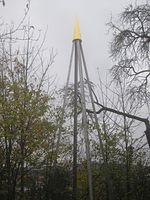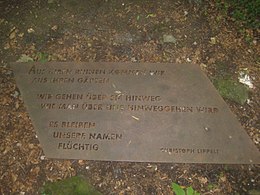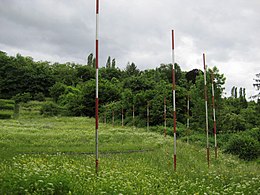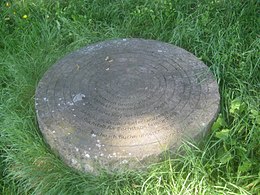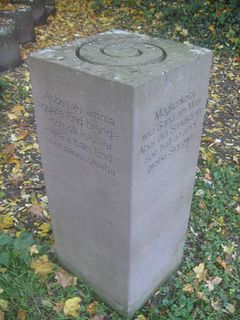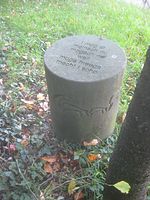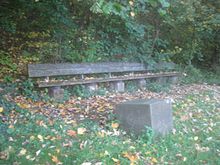Poetry stations (Stuttgart)
Poetry stations are places to linger on the Wartberg and in the Leibfriedschen Garten in Stuttgart, which, with small poem installations, invite walkers to pause for thought.
Ten poems were contributed by the Baden-Württemberg writers Heima Hasters, Christoph Lippelt, Peter Schlack , Rainer Wochele and Ulrich Zimmermann as part of the competition "The IGA and the Word" and optically staged according to designs by the graphic artist Hanns Lohrer.
Six “memorial stones” based on designs by landscape architect Hans Luz are engraved with dialect poems by Peter Schlack, which are dedicated to the “characteristics of the Swabians”.
prehistory
Station concept
In the course of the planning for the 1977 Federal Garden Show (BGS 1977) in Stuttgart, consideration was given to not including the transition area between the Lower Palace Garden and the Villa Berg in the exhibition, "because nobody would climb this mountain". One journalist countered that “you just have to give the area a nice name and people will go there too; calls it "Paradise Path" ". The design of the Paradiesweg was entrusted to Hans Luz , whose planning group had been commissioned with the framework planning for the garden show. Luz decided to make the ascent easier with intermediate stations, small themed gardens where you can linger. The result was a “station path” and the station concept was born.
To design the gardens, he brought in the graphic designer Hanns Lohrer (1912–1995) and the architects Knut Lohrer (* 1937) and Günter Hermann :
- “They built gardens with what belongs to a garden: hut, fence, plastic, motto. They [the gardens] had themes and matching names: primeval garden, water garden, perennial garden, pleasure garden, scented garden, weed garden, nightshade garden, Häfeles garden - each a little work of art in itself. "
The sayings were chosen from reading books.
planning
For the International Horticultural Exhibition in 1993 (IGA 93), Luz took up his station concept again, which he considered "an important part of our planning philosophy":
- "To make the ascent to Killesberg a little more entertaining and interesting, the station concept tried and tested on the Paradiesweg and further developed at the Baden-Baden State Horticultural Show in 1981 seemed suitable."
- “So we looked for places where destination and stopover points, stations could be created with designed condensation and invented names for the respective location: Bei der Buche, Grottenloch, Keuper, Donars Stich, Der Leibfried etc. We thought about it to connect these points with a course that reflects a curriculum vitae: love, birth, play, creation, dreams, politics, living, living and passing away. We wanted to include the word in this path and realize the whole thing together with artists and writers we know and trust. "
- "The planning group Luz / Egenhofer / Lohrer / Schlaich wanted to bring together the outer and inner nature, the park and the soul landscape."
realization
At the IGA 93, as at the State Garden Show in Baden-Baden in 1981, Luz was only allowed to implement his concept “under supervision and not as freely and easily” as at the BGS 1977. The original idea of a station path with art and word contributions was not adhered to, so that today the art stations as well as the poetry stations mostly stand as solitaires in the landscape. Nothing came of the collaboration “with artists and writers who are known and trusted”.
A competition was announced for the art stations. In 1989, a “top-class jury” selected the participating artists.
A year later, with the participation of the Association of German Writers , Landesverband Baden-Württemberg, a regional competition was announced under the title “The IGA and the Word”, in which writers from Baden-Württemberg could deliver verbal contributions such as “Aphorisms, epigrams and short lyrical forms” . A jury consisting of Michael Kienzle, Otto Jägersberg and Helmut Böttiger made a selection from the submitted contributions, and the selected texts were purchased by the City of Stuttgart.
In the competition came
- “Local writers with very different texts have their say - Heima Hasters from Karlsruhe, Christoph Lippelt, Peter Schlack and Rainer Wochele from Stuttgart, Ulrich Zimmermann from Ettlingen. Her texts are thinking marks in the literal sense, the continuous theme of which is nature: human nature, transience, nature as a task, as an object, as a vanishing point, the perverted concept of nature, nature as the enemy of nature. "
The selected poems were implemented as "poetry stations" at some art stations or small places to linger on the Wartberg and in the Leibfriedschen Garten . The texts were based on drafts by the Stuttgart graphic designer and poster artist Hanns Lohrer (1912–1995) "implemented in the area in optical form", whereby the realization of the design concept was partially impaired due to budget problems. For example, there were two designs by sculptors for the poetry station Der Wartestein by Heima Hasters, who was annoyed that these designs were ignored and "to experience my happy waiting stone as a kind of cement block or coffin half crammed into a slope, without consultation".
The IGA and the word
As part of the competition “The IGA and the Word”, ten poetry stations were created, three by Heima Hasters, two each by Christoph Lippelt, Peter Schlack and Rainer Wochele and one by Ulrich Zimmermann .
Location map
Legend
1. Heima Hasters: It doesn't matter
2. Heima Hasters: O home planet
3. Heima Hasters: The waiting stone
4. Christoph Lippelt: We come out of their ruins
The poetry station No. 4 is located outside of this plan in the art station Villa Moser. Location: see Art Station Villa Moser , Plan 2, No. 55 (dead end).
5. Christoph Lippelt: Wonderfully mild and wonderfully wild
6. Peter Schlack: Strôßa Strôßa
7. Peter Schlack: Stop Stanga
8. Rainer Wochele: I don't want to hear anything more
9. Rainer Wochele: We have to take it
10. Ulrich Zimmermann: stabat mater purpurea
Heima Hasters
The Karlsruhe writer Heima Hasters made contributions to three poetry stations.
The waiting stone
| Location: Strasbourg route, halfway between the Kunststation Among the bars and the inlet to the Menzel-Bourguiba path map
A lying stone block bears an inscription with a poem by Heima Hasters, whose title The Waiting Stone refers to the Wartberg, on the front side facing the Strasbourg Way . The waiting stone |
It does not matter
| Former location: On the banks of the Egelsee , north of the fountain, map
A large Plexiglas plate on the banks of the Egelsee carried the text of the poem It doesn't matter by Heima Hasters. The plexiglass plate has apparently disappeared. It doesn't |
O home planet
| Location: Am Weißenhof 46A, stairs, first side path on the right, map
A four-pole pyramid bears the text of the poem O Heimatplanet by Heima Hasters. O home planet |
Christoph Lippelt
The Stuttgart poet doctor Christoph Lippelt (* 1938) made contributions for two poetry stations.
We come from their ruins
| Location: Art Station Villa Moser , opposite the Belvedere , map
A lying, diamond-shaped sheet metal plate reproduces the punched-out text of a poem by Christoph Lippelt, "a dark memento mori". From their ruins we come |
Wonderfully mild and wonderfully wild
| Location: Cardiffer Weg, between the Egelsee clubhouse and the confluence with St. Helens Weg, map
A station sign - "Art Station miracle Mild, Game station cable guard" - featuring access to a rectangular Boskett from more than head-high Thujahecken. The art station, hidden between the hedges, consists of a tall pole with a small, colorful ladder on top. The ladder refers to a line of verse in Christoph Lippel's poem, which is engraved on a stone slab on the floor. The Bergwächter play station has since disappeared, just as the poem foreshadowed (“the hut fell into disrepair”). Miraculous as miraculously
wild in little huts |
Peter Schlack
The Stuttgart dialect poet Peter Schlack made several contributions to poetry stations on the Wartberg .
Stop Stanga
| Location: at the beginning of the Unter den Stangen art station , map
The beginning of the art station Unter den Stangen by Hans Dieter Bohnet is marked by a low concrete wall that closes off a rest area with three groups of benches on a cul-de-sac on Straßburger Weg. The wall is aligned with the poles of the art station and, like them, shows with its upper edge the height of 308 m above sea level . A quatrain by Peter Schlack is engraved on the top surface of the wall, who "with a wink of joy" takes on the art station "and at the same time targets the mentality of his compatriots". Halt Stanga |
Strôßa Strôßa
| Location: St.-Helens-Weg, between the Bienengarten art station and the On Top beer garden, map
The poem by Peter Schlack is printed on a white lacquered sheet metal roll that looks like a scroll and seems to be lying on a wall by chance. Strôßa Strôßa |
Rainer Wochele
The Stuttgart writer Rainer Wochele made contributions for two poetry stations in the immediate vicinity of the clubhouse at Egelsee on the Wartberg .
We have to take
|
Location: Cardiffer Weg, 40 m north-west of the clubhouse at the Egelsee, map An open box made of rusty sheet metal ("steel cabinet") stands like a memorial at a fork in the road on the western slope of the Wartberg . The punched out letters in one of the covers reproduce a poem by Rainer Wochele. We |
Don't want to hear anything more
| Location: Cardiffer Weg, west of the clubhouse at Egelsee, map
The poem “I don't want to hear more” by Rainer Wochele was engraved on the glass in the middle of a stylized satellite dish. The engraving has since disappeared. Don't want to hear anything more |
Ulrich Zimmermann
The Ettlingen writer Ulrich Zimmermann made a contribution to a poetry station.
stabat mater purpurea
| Location: Kunststation bei der Buche , map
Ulrich Zimmermann's poem was engraved into the stylized annual rings of a stone tree stump. stabat mater purpurea refers to the medieval Latin poem Stabat mater dolorosa ("The mother stood in pain"), which the mother of God Mary sang in her grief for her crucified son Jesus. Zimmermann's poem (“It was the purple beech”) sings about the copper beech that Karina Raeck wanted to provide with a protective shield through her installation. Unlike its older relatives, the large, mighty copper beech resisted the onslaught of the hurricane, according to Zimmermann, because it was more deeply rooted in the Keuper than the latter. stabat mater purpurea |
Features of the Swabians
Six dialect poems by Peter Schlack with paraphrases of the "characteristics of the Swabians" were engraved on "memorial stones" based on designs by the landscape architect Hans Luz . These poetry stations are located at the Kunststation Im Keuper on St.-Louis-Weg between Straßburger Weg and St.-Helens-Weg:
| Swabian feature | Beginning of the poem |
|---|---|
| Drink | In the wine |
| Create ´ | There are sotte |
| Save up | The grant |
| Musing | Possibility A |
| Love | I like you |
| World spirit | You machat d Auga |
|
Strasbourg way
St. Helens Way |
- Schematic map of
the locations on St.-Louis-Weg
between Straßburger Weg
and St.-Helens-Weg.
Create
| Location: St. Louis Way.
At the wine press on St.-Louis-Weg, in the back to the left of a stone bench, there is an overgrown, mossy sandstone cube with a poem by Peter Schlack engraved on the top. S gives sotte |
Save up
| Location: St. Louis Way, map
Near the confluence of St.-Louis-Weg and St.-Helens-Weg, stairs lead to a small clearing. On the right a wide wooden bench invites you to linger (see Poetry Station Weltgeist ), the seating group on the left is missing a table top or seat. A low sandstone cylinder by the seating group bears an engraving of a poem by Peter Schlack on the top surface. He |
Musing
| Location: Kunststation Im Keuper , near the viewpoint, map
In front of a rest area with a rectangular stone table and cylindrical stone stools, a sandstone stele is set up with the four stanzas of a poem by Peter Schlack on its four sides. A spiral symbol is notched into the top of the stele. Possibility like S ish but fir |
Drink
| Location: St. Louis Way.
On St.-Louis-Weg, next to a stone seating group with a round table, there is a tree-stump-shaped, half-mossed stone with a poem by Peter Schlack on its top surface.
|
Love
| Location: east of the art station Im Keuper , St.-Louis-Weg / St.-Helens-Weg, map
Near the confluence of St.-Louis-Weg and St.-Helens-Weg, a cylindrical sandstone stele is set up in a small clearing under a three-stemmed tree (poplar?) That looks like a candlestick , with a surrounding band of archaic Incised drawings of grazing animals based on a design by Peter Schlack. A poem by Peter Schlack is engraved on the top. i mog di |
World spirit
| Location: east of the Im Keuper Art Station , St.-Louis-Weg, map
Near the confluence of St.-Louis-Weg and St.-Helens-Weg, stairs lead to a small clearing. On the right, a wide wooden bench invites you to linger, while the seating group on the left lacks a table top or seat (see Sparen poetry station ). A sandstone cube is installed next to the wooden bench with a poem by Peter Schlack engraved on the top. You machat d Auga PS / 5.92
|
Status
“Usually it is left to the joy of discovery of the poetry friend on the Iga to find the poetry stations in the area.” This euphemistic description of the state can no longer be shared today, as it sometimes takes almost archaeological skill to find some poetry stations because they are clumsy in the area positioned and overgrown by plants. Since the original idea of a station path with art and word contributions was not adhered to, the poetry stations are scattered all over the site and can often only be found on the basis of a map.
The stone poetry stations are partly covered with moss and lichen and therefore difficult to decipher (e.g. the waiting stone ), partly due to their low height and near the forest edge, they are almost ingrown (e.g. drinking ). The poem text has been lost at one lyric station ( I don't want to hear anything more ), another lyric station has completely disappeared ( it doesn't matter ). There is obviously a lack of systematic care and maintenance of the poetry stations.
literature
Note: #Kienzle 1993 deals with the poetry stations that were created as part of the competition “The IGA and the Word” and contains the essay Nature-Drama. Poetic gardens. The IGA and the word , the texts of the poems and a map of the poetry stations.
- Ralf Arbogast: Stuttgart, the green experience. Recreational landscapes, parks and garden shows in the past and present , Tübingen 1993, pp. 92–93.
- Christoph Gunßer: The international horticultural exhibition Iga Expo '93 in Stuttgart . in: Deutsche Bauzeitung db. Journal for Architects and Civil Engineers 127.1993, Issue 6, pp. 14–28, here: 14, 22 (Rainer Wochele: We have to take it), 21 (Rainer Wochele: Don't want to hear anything more).
- Michael Kienzle (editor): Nature shows. On dealing with nature in the city , Tübingen 1993, pp. 9–15, 155–195.
- Hans Luz: From Vorgartenmäuerle to Green U. Forty years of landscape gardener. A work report by Hans Luz , Stuttgart 1992.
- Hans Luz: Planning and design of the permanent systems . In: Building for Agriculture 1993, Issue 1, pp. 8–18, here: 9.
- Heiner Luz: Wartberg / Steinberg and Leibfriedscher Garden . In: Elisabeth Szymczyk-Eggert: Gardens and Parks in Stuttgart , Stuttgart 1993, pp. 100–105, here: 104.
- Hans Luz: All about the Green U , manuscript, Stuttgart 2012.
- Julia Schröder: Look after the roses. “The Iga and the Word” - a project and a poetic walk . In: Stuttgarter Zeitung 1993.
- Rainer Wochele: The IGA and the Word , online (accessed in 2013).
swell
- Plan "Merksteine" from Luz + Partner, No. 684 W3 210/10 M1 / 10 of July 7, 1992, August 26, 1992 and September 14, 1992.
Web links
Individual evidence
- ↑ Sources and quotations of this section: #Luz, Hans 1992 , p. 155, #Luz, Hans 2012 , p. 43, 69.
- ↑ #Luz, Hans 2012 , p. 43.
- ↑ #Luz, Hans 2012 , p. 69.
- ↑ #Arbogast 1993 , p. 92.
- ↑ #Luz, Hans 2012 , p. 43.
- ↑ #Luz, Hans 2012 , p. 69.
- ↑ #Arbogast 1993 , p. 92.
- ↑ #Luz, Hans 1992 , S. 155th
- ↑ #Arbogast 1993 , p. 92.
- ↑ #Kienzle 1993 , p. 13.
- ↑ #Luz, Hans 1993 , p. 9.
- ↑ # Schröder 1993 .
- ^ Written communication from Heima Hasters dated November 20, 2013.
- ↑ Communication from Heima Hasters from November 20, 2013, #Arbogast 1993 , p. 92, #Luz, Hans 1993 , p. 9.
- ↑ #Arbogast 1993 , p. 92.
- ↑ This station is usually not included in the list of art stations.
- ↑ #Arbogast 1993 , pp. 92-93.
- ↑ See also: # Gunßer 1993.2 , #Wochele 2013 .
- ↑ See also: # Gunßer 1993.2 , #Wochele 2013 .
- ↑ #Luz, Hans 1992.2 , #Luz, Hans 2012 , p. 73.
- ↑ # Schröder 1993 .



















